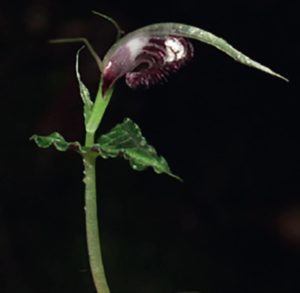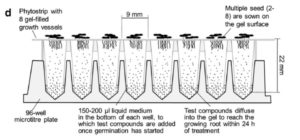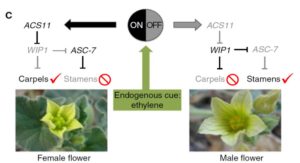IRREGULAR POLLEN EXINE1 Is a novel factor in anther cuticle and pollen exine formation
 Chen et al. identified a novel male-sterile Zea mays mutant, named ipe1. Mutant pollen grains show defective development of the tapetum and pollen exine (outer surface), causing microspore abortion. In addition, ipe1 anthers are smooth instead of reticulate, suggesting defects in anther cuticle formation. IPE1 expression is specific to the tapetum and developmentally restricted to the early uninucleate microspore stage. GC-MS analysis of anther wax and cutin content revealed that ipe1 anthers have reduced cutin monomer content relative to wild type. RNA sequencing showed over 3,000 differentially-expressed genes in ipe1, including genes involved in biosynthesis or degradation of lipids, carbohydrates, and waxes. A T-DNA mutant of the Arabidopsis IPE1 homolog shows normal anther cuticle development, but mature pollen grains have partial smooth surfaces, as in the maize mutant. The authors present a model for IPE1 functioning in anther lipid metabolism. (Summary by Daniel Czerny) Plant Physiol. 10.1104/pp.16.00629
Chen et al. identified a novel male-sterile Zea mays mutant, named ipe1. Mutant pollen grains show defective development of the tapetum and pollen exine (outer surface), causing microspore abortion. In addition, ipe1 anthers are smooth instead of reticulate, suggesting defects in anther cuticle formation. IPE1 expression is specific to the tapetum and developmentally restricted to the early uninucleate microspore stage. GC-MS analysis of anther wax and cutin content revealed that ipe1 anthers have reduced cutin monomer content relative to wild type. RNA sequencing showed over 3,000 differentially-expressed genes in ipe1, including genes involved in biosynthesis or degradation of lipids, carbohydrates, and waxes. A T-DNA mutant of the Arabidopsis IPE1 homolog shows normal anther cuticle development, but mature pollen grains have partial smooth surfaces, as in the maize mutant. The authors present a model for IPE1 functioning in anther lipid metabolism. (Summary by Daniel Czerny) Plant Physiol. 10.1104/pp.16.00629


 Which arose first during evolution- a metabolite molecule or a transporter that could move it across a membrane? Jørgensen et al. studied transporters for glucosinolate defense molecules in Brassicales species. Glucosinolates are derived from the broad class of cyanogenic glucosides, and glucosinolates are transported by GTR H+/glucosinolate symporters of the NPF transporter family. Phylogenetic analysis of NPF transporter sequences showed a subclade of GTR-like transporters in C. papaya, the most basal glucosinolate-producing species, and Brassicales species that do not produce glucosinolates, including cassava. When expressed in Xenopus oocytes, a novel transporter gene from cassava showed broad specificity for glucosinolates and cyanogenic glucosides, suggesting this is an evolutionary intermediate for NPF transporters and indicating that the ability to transport glucosinolates occurs in a species that does not produce them. Testing the specificity of C. papaya transporters for glucosinolates and cyanogenic glucosides allowed the authors to imply that preference for specific glucosinolates evolved from transporters that were originally broadly-specific for glucosinolates. So, a transporter that can move a metabolite has evolved prior to the appearance of the molecule which can be transported. (Summary by
Which arose first during evolution- a metabolite molecule or a transporter that could move it across a membrane? Jørgensen et al. studied transporters for glucosinolate defense molecules in Brassicales species. Glucosinolates are derived from the broad class of cyanogenic glucosides, and glucosinolates are transported by GTR H+/glucosinolate symporters of the NPF transporter family. Phylogenetic analysis of NPF transporter sequences showed a subclade of GTR-like transporters in C. papaya, the most basal glucosinolate-producing species, and Brassicales species that do not produce glucosinolates, including cassava. When expressed in Xenopus oocytes, a novel transporter gene from cassava showed broad specificity for glucosinolates and cyanogenic glucosides, suggesting this is an evolutionary intermediate for NPF transporters and indicating that the ability to transport glucosinolates occurs in a species that does not produce them. Testing the specificity of C. papaya transporters for glucosinolates and cyanogenic glucosides allowed the authors to imply that preference for specific glucosinolates evolved from transporters that were originally broadly-specific for glucosinolates. So, a transporter that can move a metabolite has evolved prior to the appearance of the molecule which can be transported. (Summary by  Histones are protein complexes around which genomic DNA is wrapped; post-translational modifications to histone proteins and alterations of histone protein composition affect transcription. H2A.Z is a widely conserved variant form of histone H2A that has been implicated in various forms of transcriptional regulation. Sura et al. examine the role of H2A.Z in the Arabidopsis stress response by investigating the occupancy patterns of H2A.Z and the transcriptional responses of the arp6 mutant, which is impaired in H2A.Z deposition. The authors found that H2A.Z in the gene body represses transcription of many stress-inducible genes, but that in other genes H2A.Z in the first nucleosome downstream of the transcription start site (the +1 nucleosome) is positively correlated with transcription. Thus, H2A.Z has a dual role in transcriptional regulation. Plant Cell
Histones are protein complexes around which genomic DNA is wrapped; post-translational modifications to histone proteins and alterations of histone protein composition affect transcription. H2A.Z is a widely conserved variant form of histone H2A that has been implicated in various forms of transcriptional regulation. Sura et al. examine the role of H2A.Z in the Arabidopsis stress response by investigating the occupancy patterns of H2A.Z and the transcriptional responses of the arp6 mutant, which is impaired in H2A.Z deposition. The authors found that H2A.Z in the gene body represses transcription of many stress-inducible genes, but that in other genes H2A.Z in the first nucleosome downstream of the transcription start site (the +1 nucleosome) is positively correlated with transcription. Thus, H2A.Z has a dual role in transcriptional regulation. Plant Cell  In 2016, Kew Gardens released a report “
In 2016, Kew Gardens released a report “ High-throughput screening greatly extends the number of individuals that can be screened, so is particularly crucial for genetic or chemical genetic approaches. Burrell et al. report on a miniaturized robotic phenotyping platform, “Microphenotron” designed for chemical genetic screening. Seeds are planted in phytostrips, small tubes with flat sides for improved imaging. This platform allows the effects of chemical compounds (more than 4000 treatments at a time) to be assessed by repeated imaging of the root and shoot system. Plant Methods
High-throughput screening greatly extends the number of individuals that can be screened, so is particularly crucial for genetic or chemical genetic approaches. Burrell et al. report on a miniaturized robotic phenotyping platform, “Microphenotron” designed for chemical genetic screening. Seeds are planted in phytostrips, small tubes with flat sides for improved imaging. This platform allows the effects of chemical compounds (more than 4000 treatments at a time) to be assessed by repeated imaging of the root and shoot system. Plant Methods  Brassicaceae is one of the largest angiosperm families and provides many opportunities for studies of evolution. Of course, its most famous species, Arabidopsis thaliana is an important resource, but Brassicaceae also includes the very interesting Brassica crops (cabbage, turnip) that demonstrate the power of selection. Nikolov and Tsiantis provide a thorough overview of this plant family, its evolutionary trajectories, and the contributions of genome and gene duplication in trait diversification. Curr. Opin. Plant Biol.
Brassicaceae is one of the largest angiosperm families and provides many opportunities for studies of evolution. Of course, its most famous species, Arabidopsis thaliana is an important resource, but Brassicaceae also includes the very interesting Brassica crops (cabbage, turnip) that demonstrate the power of selection. Nikolov and Tsiantis provide a thorough overview of this plant family, its evolutionary trajectories, and the contributions of genome and gene duplication in trait diversification. Curr. Opin. Plant Biol.  Most angiosperms are hermaphrodites and produce flowers that have both male (stamens / sperm) and female (carpels / egg) parts. Pannell reviews the developmental and genetic programs that lead to these “perfect” flowers, as well as those that underlie reproductive structure development in dioecious and monoecious species. His analysis further extends to bryophytes and vascular non-seed plants. He describes sex determination in plants as fundamentally a quantitative and plastic trait, with a key conclusion that “separate sexes tend to have evolved independently in different lineages, and much more recently than in most animal lineages.” Curr. Biol.
Most angiosperms are hermaphrodites and produce flowers that have both male (stamens / sperm) and female (carpels / egg) parts. Pannell reviews the developmental and genetic programs that lead to these “perfect” flowers, as well as those that underlie reproductive structure development in dioecious and monoecious species. His analysis further extends to bryophytes and vascular non-seed plants. He describes sex determination in plants as fundamentally a quantitative and plastic trait, with a key conclusion that “separate sexes tend to have evolved independently in different lineages, and much more recently than in most animal lineages.” Curr. Biol.  The range of responses an individual could display is a contribution of the inheritance of gene variants that determine such responses and the environments experienced by the individual itself and prior generations (nongenetic inheritance). In this review, we discuss recent empirical data to help us understand how the same cues experienced across and within generations (nongenetic information) contribute to progeny phenotypes and adaptation to changing environments. The predictive ability of parental and offspring environments is discussed relative to the costs of expressing a certain phenotype in the progeny, and the conflicts of responding to cues experienced by the different generations. Understanding the adaptive value of transgenerational effects seems relevant in face of the actual climate change projections. (Summary by
The range of responses an individual could display is a contribution of the inheritance of gene variants that determine such responses and the environments experienced by the individual itself and prior generations (nongenetic inheritance). In this review, we discuss recent empirical data to help us understand how the same cues experienced across and within generations (nongenetic information) contribute to progeny phenotypes and adaptation to changing environments. The predictive ability of parental and offspring environments is discussed relative to the costs of expressing a certain phenotype in the progeny, and the conflicts of responding to cues experienced by the different generations. Understanding the adaptive value of transgenerational effects seems relevant in face of the actual climate change projections. (Summary by  Plant hormones are active at very small quantities and often act differently in different cell types. Various methods, primarily involving mass spectrometry and sensors, have been developed to identify and quantify hormones with cellular-level precision. Novák et al. review these methods and discuss their strengths and limitations, as well as future perspectives in “hormonomics”. Annu. Rev. Plant Biol.
Plant hormones are active at very small quantities and often act differently in different cell types. Various methods, primarily involving mass spectrometry and sensors, have been developed to identify and quantify hormones with cellular-level precision. Novák et al. review these methods and discuss their strengths and limitations, as well as future perspectives in “hormonomics”. Annu. Rev. Plant Biol.